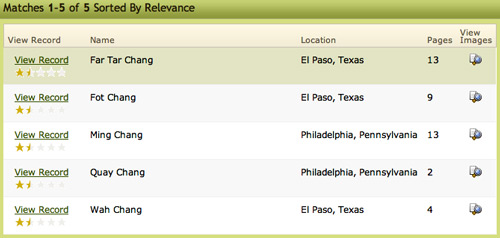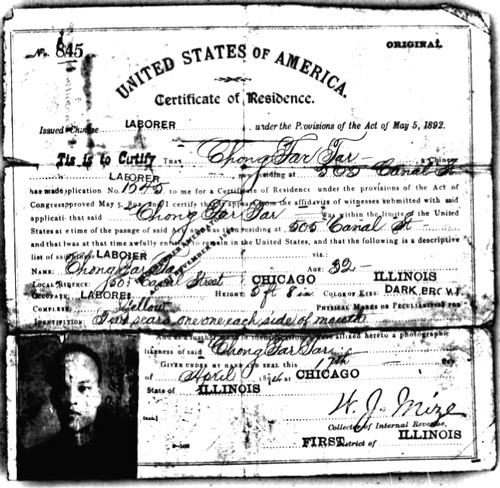Again, continuing my review of Chinese immigration records recently posted at Ancestry.com, I am concentrating my efforts this evening on the U.S. Chinese Immigration Case Files, 1883-1924. The original files are from three sources:
- The Western District Court of Texas at El Paso, 1892-1915
- The INS District No. 4 Regional Office (Philadelphia), 1900-1923
- San Francisco, California, ca. 1883-ca. 1916
The files came about because of the 1882 Chinese Exclusion Act, banning the entry of Chinese laborers into the United States for the next ten years. The act also allowed the deportation of laborers who entered the U.S. illegally. Ten years later, in 1892, the Geary Act extended the exclusion act for another ten years, with further restrictions being placed on Chinese-Americans.
This database is made up of court case files dealing with these, as well as other strict immigration laws against the Chinese. The following details of each of the three sets of data is taken directly from the Ancestry.com website.
El Paso
Some Chinese immigrants traveled to Mexico, became citizens there, and then tried to enter the U.S. as Mexicans instead of Chinese. Others tried to enter the U.S. from Mexico, claiming that they were U.S. residents but had been visiting friends and family in Mexico. El Paso, Texas is one of the ports through which Chinese immigrants tried to pass.The case files from El Paso are arranged numerically and consist of deportation orders, warrants, subpoenas, mittimuses, commitments, statements by Chinese defendants, appeal papers, orders for discharge, and bail bonds. Information provided in these records may include: name of defendant, address, birthplace, birth date, occupation, date of arrival into the U.S., and deportation date.
Philadelphia
The case files from Philadelphia are arranged numerically and consist of documentation collected by INS inspectors while investigating the background of Chinese laborers and merchants trying to enter the U.S. Among these case files are the Special Census of Chinese conducted in 1905 and the investigation of Joseph H. Lee, an INS employee who was accused of smuggling Chinese immigrants into the U.S. Information provided in these records may include: name of individual; number of brothers and sisters; details about extended family members; and details about where from.On the case file jackets some abbreviations may be written following the Chinese person’s surname. These abbreviations are translated as follows:
- D.L. – departing laborer
- D.M. – departing merchants
- M.S. – minor son
- N.B. – native born
- R.L. – returning laborer
- R.M. – returning merchant
San Francisco
The records from San Francisco consist of index cards. The images of these index cards are more or less arranged numerically by court case number, which is listed in the upper left-hand corner of each card (when present). The court name is often listed next to this number and may be written as an abbreviation. These can be translated as follows:
- USDC NDC – U.S. District Court for the Northern District of California
- USCC NDC – U.S. Circuit Court for the Northern District of California
- USDC NDNY – U.S. District Court for the Northern District of New York
Information listed on the cards may include: name of petitioner, claimant or defendant; INS San Francisco District case file number and date of arrival in the U.S.; names and INS case file numbers for relatives and witnesses; and immigration case file numbers from other INS districts.
To get an idea of exactly what the documents looked like, I did a search on the name, Chang. A fuzzy search yielded 81 results, while an exact search produced only five., three from El Paso, and two from Philadelphia. Following is a screen shot of those search results:

Noting that the file of Far Tar Chang contained 13 pages, I proceeded to check out his entire file. I found that Far Tar’s name was variously spelled Chang, Chung, and Chong. The following image shows a rather ragged document (now in the file) seeming to show that he had some right to be in the United States. Note that the document includes his picture, address, age, occupation, height, eye color, complexion, and identifying marks – all great information for one’s family history.

The following document shows his deportation. Hmmm. Looks like that first document didn’t give him any immunity from the Chinese Exclusion Act.

From the Ancestry.com website:
Source Information:
Ancestry.com. U.S. Chinese Immigration Case Files, 1883-1924 [database on-line]. Provo, UT, USA: The Generations Network, Inc., 2009. Original data:
Equity Case Files Relating to the Chinese Exclusion Acts from the Western District Court of Texas at El Paso, 1892-1915; (National Archives Microfilm Publication M1610, 34 rolls); Records of District Courts of the United States, Record Group 21; National Archives, Washington, D.C.Case Files of Chinese Immigrants from District No. 4 (Philadelphia) of the Immigration and Naturalization Series, 1895-1920; (National Archives Microfilm Publication M1144, 51 rolls); Records of the Immigration and Naturalization Service, Record Group 85; National Archives, Washington, D.C.
Register of Federal Court Cases to Chinese American and Chinese Immigrants Arriving at or Departing from San Francisco, California, ca. 1883-ca. 1916 (National Archives Microfilm Publication A3381, 1 roll); Records of the Immigration and Naturalization Service, Record Group 85; National Archives, Washington, D.C.
Now, click on over to Ancestry.com and check out these files yourself.